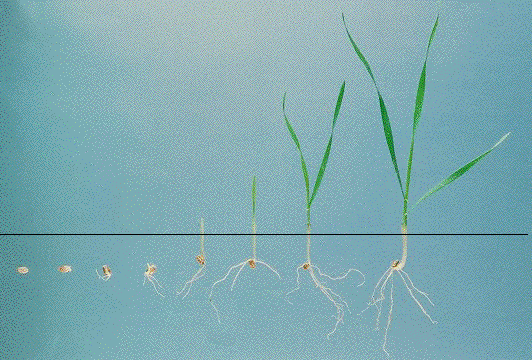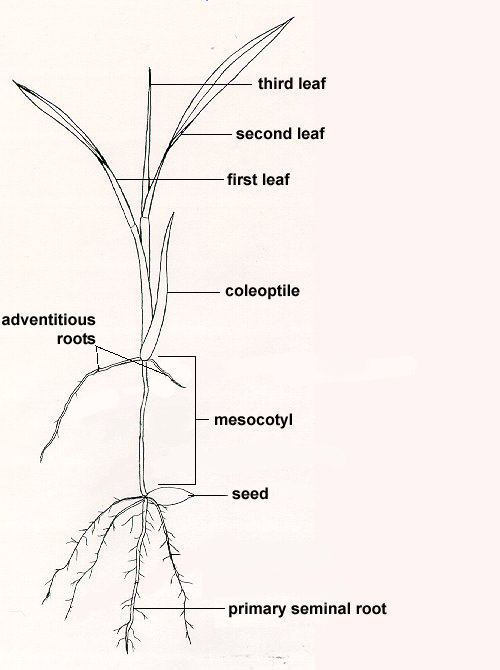The germination process begins when water is absorbed (imbibed) by the seed. This initiates several biochemical events necessary for seedling development. For example, enzymes secreted from the aleurone layer, break down starch in the endosperm converting it to simple sugars which nourish the embryo.
All structural components of the grass seedling arise from the embryo. The endosperm provides a quick source of energy for the developmental process, whereas the cotyledon (rich in fats and oils) provides energy for later stages of development.
Germination is considered complete when the radical (which becomes the primary root) ruptures the coleorhiza (root sheath) and emerges from the seed.

A "seedling" has developed when the first true leaf appears. Grass seedlings have an important structure called a coleoptile which protects and pushes the plumule through the soil. Once the coleoptile has emerged from the seed, mesocotyl elongation commences, pushing the base of the coleoptile upwards toward the soil surface.
There are actually two types of seedling development among grasses. Most grasses have an elonagated area just below the coleoptile called a mesocotyl. Some grasses, such as crested wheatgrass, have no elongation in the mesocotyl, below the coleoptile, but have a long coleoptile.
When the coleoptile breaks through the soil crust and is exposed to light (particularly red and/or far-red light), the mesocotyl ceases elongation. If the coleoptile is shielded from red light, as with severe shading, the mesocotyl may continue elongation to the extent that is pushes the coleoptile base above the soil surface. This causes the seedling to lodge and later perish due to poor crown development.


The mesocotyl arises from the embryonic axis (cotyledonary or scutellar node) and terminates at the base of the coleoptile. Mesocotyl elongation depends upon energy reserves in the seed. Seedlings often fail with deep seed placement due to inability of the mesocotyl to raise the coleoptile to the soil surface. In this event the leaves may unfurl beneath the soil crust resulting in seedling death.
With exposure to light, seedling leaves begin to supply energy through the process of photosynthesis. At this point the seedling becomes independent of the seed for its food supply.
The primary root, together with the closely associated seminal roots, constitute a root system capable of temporarily supplying water and inorganic nutrients to the seedling. These roots function until adventitious roots, arising from crown tissue, form the permanent root system. The more hairy adventitious roots permeate a large volume of soil and are more efficient than the primary, seminal root system.
Seedling growth and development during germination is totally dependent on energy reserves stored in the seed. Thus, with deep seed placement, the coleoptile may fail to break through the soil surface. In this event, the first true leaf, as yet contained in the coleoptile, will likely unfurl beneath the soil surface. The leaf, without the aid of the coleoptile, is unable to penetrate the soil surface. Failure of the coleoptile to reach the soil surface is due chiefly to insufficient energy reserves to support mesocotyl elongation. The combined forces associated with mesocotyl elongation and coleoptile growth are normally sufficient to break through the soil crust.
Exposure of the coleoptile tip to light stops mesocotyl elongation at the perfect position for leaf emergence. If mesocotyl elongation is insufficient (due to deep planting or poor quality shriveled seed), the first leaf may be unfurled beneath the soil surface and the seedling will perish.
The smaller the seed, the shallower the recommended planting depth. Plant grass seeds no deeper than 5 times their diameter. Thus, small seeded grasses like timothy should be just barely covered by soil, no more than 1/8 to 1/4 inch deep. Large grass seeds like corn may be planted 1 to 1 1/2 inches deep.
Management scenarios that reflect this material are: Shriveled grain implications and Planting depth / soil. These are located in the management segment of this project.